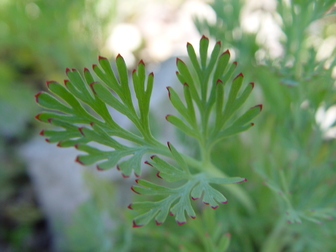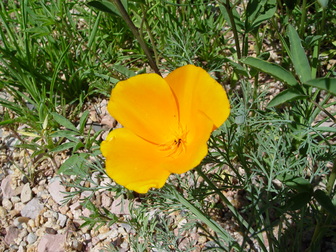Back to Tour: Medicinal Plants Tour
|
Eschscholzia californica California Poppy Eschscholzia californica 920162*1 is no longer in the Denver Botanic Gardens plant collection. |
Denver Botanic Gardens
Gardens Navigator 
|
|
Accession Number: 920162*1 Map | Images | |
| More about Eschscholzia californica | |
| TOUR DETAILS |
Medicinal uses: California poppy is considered an antispasmodic, analgesic and sedative. Research shows that it has been found to be helpful for children overcoming bedwetting, difficulty sleeping, as well as nervous tension. Adults have taken this poppy in helping to combat insomnia. Scientists have found that California poppy does not depress the nervous system as opium poppy does. Because of this, California poppy has been used in the past to treat ADD as well as ADHD in children and young adults. A tincture of the plant has been effective when applied to cuts and scrapes. Mythology/Folklore: Can you pronounce this Latin name? California poppy gets its name because it became the state flower for California in 1903. Every April 6 is considered California Poppy Day in California. This plant is related to the famous opium poppy genus but is not considered a narcotic. Poppies throughout history have been tied to sleep, due to their sedative properties. In Greek mythology, Hypnos, the god of sleep, carried a poppy stalk with him. In the Victorian language of flowers, poppy symbolized sleep. One user of California poppy claimed that he attempted to roll the dried flower into cigarettes in hopes of getting the same effect as the opium poppy but was unsuccessful. Medicinal recipe: California Poppy Salve Ingredients: 2 cups of plant infused oil (made from 2 cups olive oil, 3/4 cup dried plant), 1/2 cup of beeswax, 3 tbsp coconut oil, 2 tbspn shea butter, 5 drops tea tree oil, 5 drops lavender oil First the olive oil needs to be infused with the qualities of the plants and this can either been done by combining oil and plant in a jar and leaving on a windowsill in the sun for two weeks. After two weeks, strain the oil through a strainer then once again through fine cloth to filter any finer particles. Melt the oils and beeswax together gently until just melted. Add the essential oils and pour into clean tins/jars to set. This will last up to 2 years and make around 3 cups. Culture: (from staff horticulturalist Mike Kintgen) sow the California poppy seeds in a well-drained soil. This plant enjoys sunny areas. It’s best to sow these seeds in cold months, typically from October to March. Water the seedlings frequently when first growing, but after the plant has been established, little maintenance is needed. |
| LOCATION GROUP | Rock Alpine Garden; Rock Alpine Garden, Upper Meadow |
| FAMILY NAME | Poppy Family |
| FAMILY | Papaveraceae |
| ACCESSION DATE |
March 10, 1992 (When this plant was acquired and registered in the database) |
| FLOWER COLOR | orange;yellow |
| FLOWER COLOR NOTE | variable |
| USDA HZ | 9 (Coldest Zone Where Hardy) |
| HABIT | Herbaceous (Non-woody) |
| SOIL | Well-drained soil |
Location Map for 920162*1 Eschscholzia californica
Map Help
Flowering
When Eschscholzia californica has been observed flowering at Denver Botanic Gardens
 | ||||||||||||||||||||||||||||||||||||||||||||||||||||
| AVE. |  |
 |
 |
 |
 |
 |
 |
 |
 |
 |
 |
 |
 |
 |
 |
 |
 |
 |
 |
 |
 |
 |
 |
 |
 |
 |
 |
 |
 |
 |
 |
 |
 |
 |
 |
 |
 |
 |
 |
 |
 |
 |
 |
 |
 |
 |
 |
 |
 |
 |
 |
 |
| 2016 |  |
 |
 |
 |
 |
 |
 |
 |
 |
 |
 |
 |
 |
 |
 |
 |
 |
 |
 |
 |
 |
 |
 |
 |
 |
 |
 |
 |
 |
 |
 |
 |
 |
 |
 |
 |
 |
 |
 |
 |
 |
 |
 |
 |
 |
 |
 |
 |
 |
 |
 |
 |
| 2015 |  |
 |
 |
 |
 |
 |
 |
 |
 |
 |
 |
 |
 |
 |
 |
 |
 |
 |
 |
 |
 |
 |
 |
 |
 |
 |
 |
 |
 |
 |
 |
 |
 |
 |
 |
 |
 |
 |
 |
 |
 |
 |
 |
 |
 |
 |
 |
 |
 |
 |
 |
 |
| 2013 |  |
 |
 |
 |
 |
 |
 |
 |
 |
 |
 |
 |
 |
 |
 |
 |
 |
 |
 |
 |
 |
 |
 |
 |
 |
 |
 |
 |
 |
 |
 |
 |
 |
 |
 |
 |
 |
 |
 |
 |
 |
 |
 |
 |
 |
 |
 |
 |
 |
 |
 |
 |
| 2006 |  |
 |
 |
 |
 |
 |
 |
 |
 |
 |
 |
 |
 |
 |
 |
 |
 |
 |
 |
 |
 |
 |
 |
 |
 |
 |
 |
 |
 |
 |
 |
 |
 |
 |
 |
 |
 |
 |
 |
 |
 |
 |
 |
 |
 |
 |
 |
 |
 |
 |
 |
 |
| 2005 |  |
 |
 |
 |
 |
 |
 |
 |
 |
 |
 |
 |
 |
 |
 |
 |
 |
 |
 |
 |
 |
 |
 |
 |
 |
 |
 |
 |
 |
 |
 |
 |
 |
 |
 |
 |
 |
 |
 |
 |
 |
 |
 |
 |
 |
 |
 |
 |
 |
 |
 |
 |
Fruiting
When Eschscholzia californica has been observed fruiting at Denver Botanic Gardens
 | ||||||||||||||||||||||||||||||||||||||||||||||||||||
| 2016 |  |
 |
 |
 |
 |
 |
 |
 |
 |
 |
 |
 |
 |
 |
 |
 |
 |
 |
 |
 |
 |
 |
 |
 |
 |
 |
 |
 |
 |
 |
 |
 |
 |
 |
 |
 |
 |
 |
 |
 |
 |
 |
 |
 |
 |
 |
 |
 |
 |
 |
 |
 |
| 2013 |  |
 |
 |
 |
 |
 |
 |
 |
 |
 |
 |
 |
 |
 |
 |
 |
 |
 |
 |
 |
 |
 |
 |
 |
 |
 |
 |
 |
 |
 |
 |
 |
 |
 |
 |
 |
 |
 |
 |
 |
 |
 |
 |
 |
 |
 |
 |
 |
 |
 |
 |
 |
Images © Denver Botanic Gardens
 920162*1 Eschscholzia californica |
 920162*1 Eschscholzia californica |
 920162*1 Eschscholzia californica |
|
| ^Top of Page |

© Denver Botanic Gardens, 1007 York Street, Denver, CO 80206
Photography © Denver Botanic Gardens

Powered by







 E-mail
E-mail